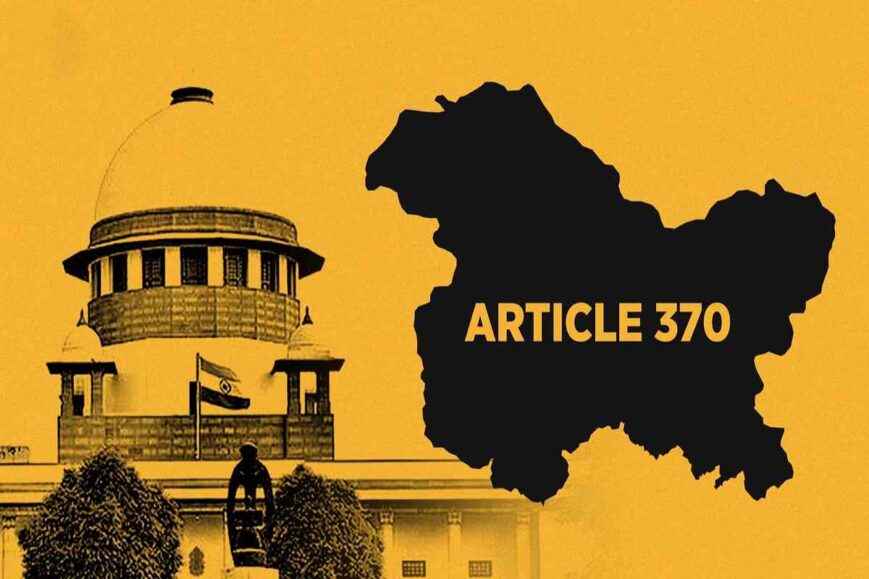Article 370 and the Supreme Court or Debate. The presented paper aims to reveal the complexities of the history of the concept of the ‘mediated breakdown of communication.’
What is Article 370?
This provision in the Indian Constitution has been hugely contentious for decades. Article 370 enabled the Government of Jammu and Kashmir to have its own Constitution, flag, and control over internal affairs.
To understand the history behind Article 370, one has to go back to the events that took place at the time of the accession of the kingdom of Kashmir to the Indian Union in 1947. During that period, the Indian government had to allow Kashmir to join the Union. Article 370 was added to the Constitution of India in 1949 as a ‘Section 3’ as and when the state of J&K was given autonomy.
The state’s autonomy was gradually reduced over the years, and eventually, the article was diluted in its applicability. Several critics claimed that this special status fuels separatism in the region of Kashmir. Some people argued that Article 370 was the only way to protect the culture and identity of the Kashmiri people within the Indian federation. This debate raged on for years into decades.
The Turning Point was played in 2019
In August 2019, the government passed a resolution in Rajya Sabha that made significant changes.
- Thus, the 1954 order was effectively annulled by putting into force Article 370. Primarily, J&K’s special status was abolished.
- The existing state of J&K was divided into two new Union Territories: the UT of Jammu & Kashmir and the UT of Ladakh.
This movement was well regarded as the most significant controversy. Some people believed it would help free the territory of terrorism and facilitate development in Jammu and Kashmir. Some political analysts and human rights activists accused the government of working over the people of Kashmir, which was unconstitutional.
The legal issues that may arise at the Supreme Court level include the following;
As you know, immediately after the changes were made, the opposition parties and activists turned to the Supreme Court to seek to have the changes reversed.
Their key arguments were:
- Article 370 is a constitutional provision that cannot be amended or removed in any way, let alone by the presidential order.
- Even today, to change the status of the state, the consent of the J&K constituent assembly is obligatory, although it was dissolved in 1957.
- The division of J&K into two opposite parts is against the provisions of Article 370 of the Constitution of India, which deals with citizens’ fundamental rights.
Nonetheless, the Supreme Court threw all the petitions filed to appeal the government’s act. In its ruling, the apex court said: In its ruling, the apex court said:
- It is essential to clear the misconception that Article 370 was always framed as a permanent provision. The President can amend it, but the changes should not contradict the Constitution.
- The Presidential Order wielded the dissolved constituent assembly by substituting it with the state assembly.
- Division of J&K into UTs was constitutionally permissible within the realm of Parliament.
Finally, With this verdict, the Supreme Court gave a clean chit to the government regarding the property in Article 370. As for the future, the previous state has been divided into two parts, now Union Territories with lesser power.
The Verdict’s Significance
The judgment given by the Supreme Court regarding the revocation of Article 370 has a broader impact. From a legal perspective, it resolves an ongoing debate on the legal status of J&K since the government passed the reorganization act. On the political level, the map of the region and its governmental structures are altered completely.
On a social aspect, people of J&K have both positive and negative impacts with the onset of this new arrangement. For many Kashmiris, this is perceived as an infringement on their liberties and the forging of their character. But its supporters believe that by enhancing integration the two areas will be made more secure and developed.
Conclusion
The law of the matter was adjudicated: the manifold social and political implications will keep unfolding. However, the definitive stamp of the apex court adds a symbolic value to the situation. It could be said that the chapter regarding the special status of Article 370 in the Indian Constitution has come to its conclusion. Hence, in the future, J&K will start a new journey as a complete UT under the direct jurisdiction of the Union.

